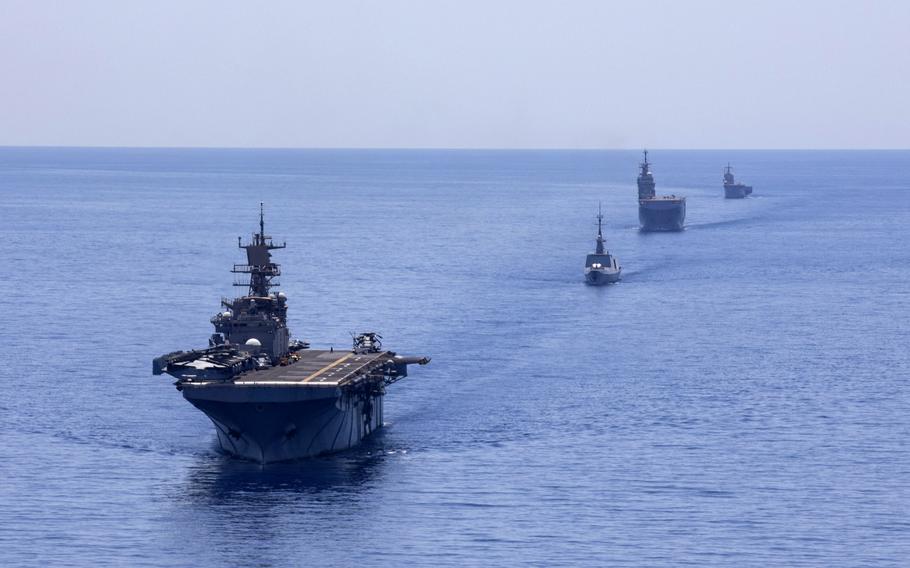
From left, the amphibious assault ship USS Bataan, the French frigate FS Guepratte, the French amphibious assault ship FS Mistral and the Italian amphibious transport dock ship ITS San Giorgio sail in formation as part of a maritime training exercise, June 24, 2020. (Lenny Weston/U.S. Navy)
STUTTGART, Germany — A Russian buildup is turning the eastern Mediterranean Sea into one of the world’s most militarized zones, the U.S. Navy’s top admiral in Europe has said, warning that Moscow could cement its dominance in the region if it’s allowed to gain a foothold in Libya.
“The eastern Mediterranean is becoming one of the most kinetic areas in the world,” Adm. James Foggo, head of U.S. Naval Forces Europe and Africa, said Thursday in a virtual seminar hosted by the International Institute for Strategic Studies.
“The Russians are deploying quiet, modern diesel submarines capable of launching Kalibr cruise missiles. A Kilo-class submarine can go anywhere in European waters and strike any European or North African capital from under the waves,” he said from Naples, Italy, where NAVEUR has its headquarters. “This highlights the need to maintain a vigilant, highly capable naval presence throughout European waterways.”
Crimea, which Russia annexed from Ukraine in 2014, and a base in the coastal Syrian city of Tartus, have become air defense and maritime hubs for Russia, Foggo said.
Libya could be next, he warned.
Last month, U.S. Africa Command called out Russia for sending mercenaries and more than a dozen fighter planes into the north African country. The presence of the aircraft, which have since become operational, could be a prelude to a larger Russian presence, US military officials have said.
“Now, think about what Russia is doing in Crimea and Tartus, and what threat they could pose by gaining a stronghold in Libya,” Foggo said.
U.S. forces in the region have had several close encounters with the Russian military, including incidents where Russian fighter planes buzzed Navy reconnaissance aircraft on three occasions in April and May, in maneuvers the Navy condemned as unsafe.
Foggo, who will retire later this summer after a 39-year career, said allies must develop a maritime strategy that accounts for new threats, such as the resurgence of Russia’s submarine force and increased Chinese activity in Europe. China has been expanding its influence on the Continent and its interest in the Arctic, where Russia also is a force.
“We need to come up with a new strategy that helps us move forward in an increasingly complex geostrategic landscape,” he said.
vandiver.john@stripes.com Twitter: @john_vandiver